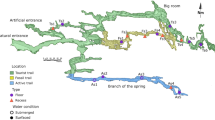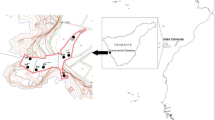Abstract
Submarine caves display a paucity of benthic density and biomass that may be related to low trophic resources. Analysis of organic carbon, organic nitrogen, carbohydrate, protein and lipid content of suspended particulate matter was made during the period July 1985–July 1987 in a Mediterranean cave (Marseille, France) in order to determine any differences in the particulate organic matter composition along an horizontal transect. Particulate organic matter content clearly declined from the entrance of the cave to the dark inner area. This impoverishment could not be explained by a simple decrease in a few organic compounds, but appeared to be related to the combination of a decrease in both the amount and the composition of the suspended particles. Three progressive levels of impoverishment were identified towards the dark inner area of the cave: (i) decreasing amounts of seston; (ii) decreasing organic content of particles; (iii) increasing proportions of the geopolymeric (i.e., humic) components in the remaining organic matter, indicating increased degradation. The cave appeared to be sharply divided into two distinct sections — a twilight outer section whose waters contained slightly lower amounts of particulate organic matter than the open sea, and a dark inner section, 8 to 10 m higher, separated from the outer section by a steep rise and with waters of low organic matter content. The water in the twilight section appeared to be in thermal equilibrium with the open sea, and that in the dark inner section displayed thermal stratification. These differences indicated the presence of two distinct water bodies with contrasting average residence times, estimated as 1 d in the outer twilight section and 8 d in the dark inner section. The joint action of sedimentation and degradation resulted in an abrupt depletion of particulate organic matter in the dark inner section accompanied by a decrease in the benthic fauna. The decline in benthic heterotroph populations is probably related to the abrupt transition to oligotrophic conditions.
Similar content being viewed by others
Literature cited
Amenta, J. S. (1964). A rapid chemical method for quantification of lipids separated by thin layer chromatography. J. Lipid Res. 5: 270–272
Barnes, H., Blackstock, J. (1973). Estimation of lipids in marine animal and tissue: detailed investigation of the sulphophosphovanilin method for “total” lipids. J. exp. mar. Biol. Ecol. 12: 103–118
Bradford, M. M. (1976). A rapid sensitive method for the quantitation of microgram quantities of protein utilizing the principle of protein-dye binding. Analyt. Biochem. 72: 248–254
Brett, J. R., Groves, T. D. D. (1979). Physiological energetics. In: Hoar, W. S. (ed.) Fish physiology. Vol. 8. Bioenergetics and growth. Academic Press, New York, p. 279–352
Brody, S. (1945). Bioenergetics and growth. Hafner Publications, New York
Cauwet, G. (1978). Organic chemistry of sea water particulates, concepts and developments. Oceanol. Acta 1: 99–105
Cauwet, G. (1981). Non-living particulate matter. In: Duursma, E. K., Dawson, R. (eds.) Marine organic chemistry. Evolution, composition, interactions and chemistry of organic matter in sea water. Elsevier, Amsterdam, p. 71–90
Chervin, M. B., Malone, T. C., Neale, P. J. (1981). Interactions between suspended organic matter and copepod grazing in the plume of the Hudson River. Estuar., cstl Shelf Sci. 13: 169–183
Chevolot, L., Senior, W., Courtot, P. (1985). Origine des carbohydrates particulaires et problèmes posés par le dosage des sucres: premiers résultats concernant le rade de Brest. Océanis, Paris 11: 367–382
Claustre, H., Marty, J. C., Cassiani, L. (1989). Intraspecific differences in the biochemical composition of a diatom during a spring bloom in Villefranche-sur-Mer Bay, Mediterranean Sea. J. exp. mar. Biol. Ecol. 129: 17–32
Craig, J. F., Kenley, M. J., Tailling, J. F. (1978). Comparative estimations of the energy content of fish tissue from bomb calorimetry, wet oxidation and proximate analysis. Freshwat. Biol. 8: 585–590
Dame, R., Chrzanowski, T., Bildstein, K., Kjerfve, B., McKellar, H., Nelson, D., Spurrier, J., Stancyk, S., Stevenson, H., Vernberg, J., Zingmark, R. (1986). The outwelling hypothesis and North Inlet, South Carolina. Mar. Ecol. Prog. Ser. 33: 217–229
Dawson, R., Liebezeit, G., Josefsson, B. (1983). Determination of amino acids and carbohydrates. In: Grasshoff, K., Ehrardt, M., Kremling, K. (eds.) Methods of sea water analysis. Kiel Verlag Chemie, Kiel, p. 319–346
Dubois, M., Gilles, K. A., Hamilton, J. K., Rebers, P. A., Smith, F. (1956). Colorimetric method for determination of sugars and related substances. Analyt. Chem. 28: 350–356
Etcheber, H., Heral, M., Relexans, J. C. (1985). Protocoles d'extraction chimique de la matière organique particulaire: application au domaine estuarien. Océanis, Paris 11: 409–428
Fichez, R. (1989). Phénomènes d'oligotrophie en milieu aphotique. Etude des grottes sous-marines, comparaison avec les milieux profonds et bilans énergetiques. Thèse de Doctorat de l'Université d'Aix-Marseille II, Marseille
Fichez, R. (1990a). Les pigments chlorophylliens: indices d'oligotrophie dans les grottes sous-marines. C. r. hebd Séanc. Acad. Sci., Paris (Sér. III) 310: 255–261
Fichez, R. (1990b). Decrease in allochtonous organic inputs in dark submarine caves, connection with lowering in benthic community richness. Hydrobiologia 207: 61–69
From, J., Rasmussen, G. (1984). A growth model, gastric evacuation, and body composition in rainbow trout,Salmo gairdneri Richardson. Dana 3: 61–139
Garret, P. (1969). The geology and biology of large cavities in Bermuda reefs. Spec. Publs. Bermuda biol. Stn Res. 2: 77–85
Gili, J. M., Riera, T., Zabala, M. (1986). Physical and biological gradients in a submarine cave on the Western Mediterranean coast (north-east Spain). Mar. Biol. 90: 291–297
Harmelin, J. G., Vacelet, J., Vasseur, P. (1985). Les grottes sousmarines obscures: un milieu extrême et un remarquable biotope refuge. Téthys 11: 214–229
Hartman, W. D., Goreau, T. F. (1970). Jamaican coralline sponges: their morphology, ecology and fossil relatives. Symp. zool. Soc. Lond. 25: 205–243
Henken, A. M., Lucas, H., Tijssen, P. A. T., Machiels, M. A. M. (1986). A comparison between methods used to determine the energy content of feed, fish, and faeces samples. Aquaculture, Amsterdam 58: 195–201
Heral, M., Deslous-Paoli, J. M., Sornin, J. M. (1983). Transferts énergétiques entre l'huitreCrassostrea gigas et la nourriture potentielle disponible dans un bassin ostréicole: premieres approaches. Océanis, Paris 9: 169–194
Horn, M. H., Neighbors, M. A., Murray, S. N. (1986). Herbivore responses to a seasonally fluctuating food supply: growth potential of two temperate intertidal fishes based on the protein and energy assimilated from their macroalgal diets. J. exp. mar. Biol. Ecol. 103: 217–234
Iliffe, T. M., Wilkens, H., Parzefall, J., Williams, D. (1984). Marine lava cave fauna: composition, biogeography, and origins. Science, N.Y. 225: 309–311
Johnson, K. M., Sieburth, J. McN. (1977). Dissolved carbohydrates in sea water. I. A precise spectrophotometrie analysis for monosaccharides. Mar. Chem. 5: 1–13
Khripounoff, A., Crassous, P., Desbruyeres, D., Le Coz, J. R. (1985). Le flux organique particulaire et ses transformations a l'interface eau-sediment. In: Laubier, L., Monniot, C. (eds.) Peuplements profonds du Golfe de Gascogne. IFREMER, Brest, France, p. 101–118
Krey, J. (1951). Quantitative Bestimmung von Eiweiss im Plankton mittels der Biuretreaktion. Kieler Meeresforsch. 8: 16–29
Krey, I. (1964). Die mittlere Tiefenverteilung von Seston Mikrobiomasse und Detritus im nordlichen Nordatlantik. Kieler Meeresforsch. 20: 18–29
Lieth, H. (1975). Measurement of caloric values. In: Lieth, H., Whittaker, R. H. (eds.) Primary production of the biosphere. Springer Verlag, New York, p. 119–129
Logan, A. (1981). Sessile invertebrate coelobite communities from shallow reef tunnels, Grand Cayman, B.W.I. Proc. 4th int. coral Reef Symp. 1: 205–213. [Gomez, E. D. et al. (eds.)] Marine Sciences Center, University of the Philippines, Quezon City, Philippines]
Lowry, O. H., Rosenbrough, R. J., Farr, L., Randal, R. J. (1951). Protein measurements with the folin phenol sulfuric acid method. Wat. Res. 7: 741–746
Marinopoulos, J. (1988). Etude des peuplements infralittoraux de substrats rocheux de la région de Marseille et des facteurs abiotiques (lumière, hydrodynamique) les influençant. Thèse Doctorat ès Sciences Université d'Aix-Marseille II, Marseille
Marsh, B. J., Weinstein, D. B. (1966). Simple charring method for determination of lipids. J. Lipid Res. 7: 574–576
Mayzaud, P., Chanut, J. P., Ackman, R. G. (1989). Seasonal changes of the biochemical composition of marine particulate matter with special reference to fatty acids and sterols. Mar. Ecol. Prog. Ser. 56: 189–204
Mayzaud, P., Taguchi, S., Laval, P. (1984). Seasonal patterns of seston characteristics in Bedford basin, N.S., relative to zooplankton feeding: a multivariate approach. Limnol. Oceanogr. 29: 745–762
Moal, J., Samain, J. F., Le Coz, J. F., Daniel, J. Y. (1985). Protéines, glucides, lipides particulaires: aspects méthodologiques. Océanis, Paris 11: 487–502
Monteiro-Marques, V. (1981). Peulements de planchers envasés de trois grottes sous-marines de la région de Marseille. Etude préliminaire. Téthys 10: 89–96
Pérès, J. M. (1982). Major benthic assemblages. In: Kinne, O. (ed.) Marine ecology. Vol. 5. Wiley & Sons, Chichester, p. 373–522
Poulet, S. A., Cossa, D., Marty, J. C. (1986). Combined analysis of the size spectra and biochemical composition of particles in the St Lawrence estuary. Mar. Ecol. Prog. Ser. 30: 205–214
Riedl, H. M. (1966). Biologie der Meereshöhlen. Springer Verlag, Berlin
Riley, G. A., Van Hemert, D., Wangersky, P. J. (1965). Oceanic aggregates in surface and deep waters of the Sargasso Sea. Limnol. Oceanogr. 10: 354–363
Saliot, A., Lorre, A., Marty, J. C., Scribe, P., Tronczynski, J., Meybeck, M., Dessery, S., Marchand, M., Caprais, J. C., Cauwet, G., Etcheber, H., Relexans, J. C., Ewald, M., Berger, P., Belin, C., Gouleau, D., Billen, G., Somville, M. (1984). Biogéochimie de la matièrew organique en milieu estuarien: stratégies d'échantillonage et de recherche élaborées en Loire (France). Oceanol. Acta 7: 191–207
Salonen, K., Sarvala, J., Hakala, I., Viljanen, M. L. (1976). The relation of energy and organic carbon in the aquatic invertebrates. Limnol. Oceanogr. 21: 724–730
Sket, B. (1981). Fauna of anchialine (coastal) cave waters, its origin and importance. In: Beck, B. F. (ed.) Proceedings of the Eighth International Congress on Speleology. National Speleological Society, Huntsville, Alabama, USA, p. 645–647
Vasseur, P. (1974). The overhangs, tunnels and dark reef galleries of Tulear (Madagascar) and their sessile invertebrate communities. Proc. 2nd int. coral Reef Symp. 2: 143–159 [Cameron, A. M. et al. (eds.) Great Barrier Reef Commitee, Brisbane]
Weinberg, S. (1975). Ecologie des octocoralliaires communs du substrat dur dans la région de Banyuls-sur-mer. Bijdr. Dierk. 45: 50–70
Author information
Authors and Affiliations
Additional information
Communicated by J. M. Pérès, Marseille
Rights and permissions
About this article
Cite this article
Fichez, R. Suspended particulate organic matter in a Mediterranean submarine cave. Mar. Biol. 108, 167–174 (1991). https://doi.org/10.1007/BF01313485
Accepted:
Issue Date:
DOI: https://doi.org/10.1007/BF01313485




